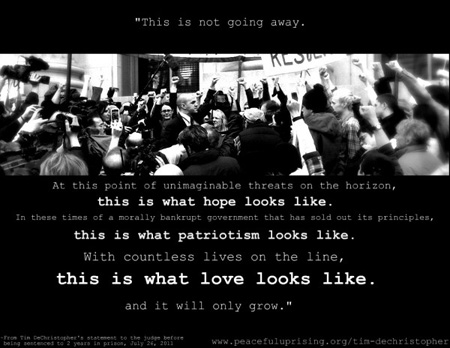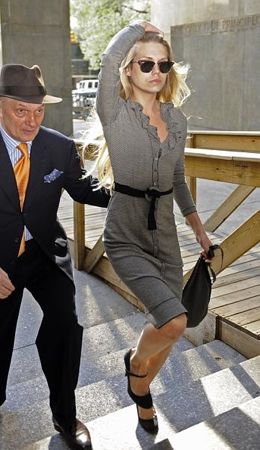We join the court session already in progress. The prosecution has just finished giving its opening statement.
JUDGE
Defense counsel? Will you be making an opening statement at this time?
DEFENSE
Yes, your honor.
JUDGE
Please proceed.
The Defense Counsel remains seated. He or she stares straight ahead, hands laid flat on the surface of the defense table. The jurors are silent, watching. The silence lengthens; five seconds, ten seconds.
DEFENSE
(still staring straight ahead)
The earth... is flat.
The Defense Counsel, still sitting, lays his or her head on the table and sights along it.
DEFENSE (CONT.)
That’s a simple explanation. Right? Nice and simple. Just take a look. Sure looks flat to me. Done.
The Defense Counsel slaps a hand on the table, then brushes both hands together in a gesture of finality.
DEFENSE (CONT.)
Or how about this: The earth is the center of the universe, and the sun and stars revolve around it.
The Defense Counsel points at the ceiling, tracking the path of an imaginary celestial body across the sky.
DEFENSE (CONT.)
Simple. Obvious. I mean, look: There it goes.
The Defense Counsel turns, and for the first time, looks at the jury.
DEFENSE (CONT.)
This case... is simple.
The Defense Counsel stands, then walks into the well in front of the jury.
DEFENSE (CONT.)
The flat earth, the sun and stars revolving around it, the prosecution’s simple explanation for the case of Dr. Peter Gleick: All of those are things that, from a certain perspective, are easy to believe. But in each case, that belief is wrong. Because the earth is not flat. It is not the center of the universe. And the case of Dr. Peter Gleick, when you look at it with an honest and open mind, is anything but simple.
The Defense Counsel turns and walks slowly away from the jury for a few paces, then turns and faces them again.
DEFENSE (CONT.)
William of Ockham. William of Ockham was an English friar who lived in the 1300’s. He’s remembered today for one thing: a principle of logic called “Occam’s razor.” Basically, it says if you have two explanations for something, you should prefer whichever explanation is simpler.
The Defense Counsel smiles, and gestures toward the Prosecutor.
DEFENSE (CONT.)
The prosecution is a big fan of William of Ockham. Because the explanation they want you to believe is a simple one: You’ve got this one guy, the defendant, Dr. Peter Gleick, who admits doing a bad thing. So he must be the bad guy. The people he did the bad thing to, the Heartland Institute? They must be the good guys. So if you’ve got anything else you need to explain, you just find a way to fit it into that theory. There’s a mysterious strategy memo that paints Heartland in a bad light? Well, they’re the good guys, so the memo must not be true. Who would fake such a thing? Oh, right: the bad guy, Dr. Gleick. Easy!
The Defense Counsel brushes his or her hands together and walks briskly away, then slows, stops, and turns back toward the jury.
DEFENSE (CONT.)
Or is it? Albert Einstein once said, “Everything should be kept as simple as possible, but no simpler.” What he meant was, you have to get the facts of the situation first, before you try to come up with a theory to explain those facts. Using Occam’s Razor before you know the facts is a good way to cut your own throat. It’s a good way to come up with a theory that says the Earth is flat, or the sun and stars revolve around it. Sure, it’s simple. But it’s wrong.
The Defense Counsel walks up to the jury box and stands directly in front of it, looking the jurors in the eyes by turn.
DEFENSE (CONT.)
The prosecution has a theory of what happened in this case. Their theory is simple. But it doesn’t account for all the facts. Facts like these:
The Defense Counsel ticks off “one” on his or her fingers.
DEFENSE (CONT.)
Fact: The organization whose internal documents Dr. Gleick obtained, the Heartland Institute, is not some innocent victim, a poor little think tank promoting research and education. They are sophisticated liars, with an extremist ideological agenda and a history of pushing misleading information intended to confuse the public about things like the health risks of cigarettes and the dangers of pollution.
The Defense Counsel ticks off “two.”
DEFENSE (CONT.)
Fact: At least one person associated with Heartland publicly identified Dr. Gleick as the likely source of the leaked documents days before Dr. Gleick admitted doing so. How did that person know Dr. Gleick was the source? Was it from a remarkably astute reading of clues in the strategy memo itself, as the prosecution would have you believe? Or was it that the accuser knew Dr. Gleick was the source, because the accuser had forged the strategy memo himself and intentionally leaked it to Dr. Gleick beforehand?
The Defense Counsel ticks off “three.”
DEFENSE (CONT.)
Fact: Dr. Gleick is not a stupid man. By his own admission he showed bad judgement under pressure, but that’s not the same thing as being stupid. Yet the prosecution’s so-called “simple” explanation requires us to believe that Dr. Gleick, having obtained Heartland’s internal documents, was stupid enough to think it would be a good idea to forge an additional document that made Heartland look worse, even though that additional document contained almost nothing new that was not already present in the legitimate documents.
The Defense Counsel scowls.
DEFENSE (CONT.)
According to the prosecution’s theory, Dr. Gleick was stupid enough to think it would be a good idea to release this forged document along with the legitimate ones, even though Heartland would immediately know it was a fake. Even though he would be handing Heartland a made-to-order way to cast themselves as victims and shift attention to the forgery, rather than to the embarrassing information in the real documents. According to the prosecution’s “simple” theory, Dr. Gleick was stupid enough to think it was a good idea to include a direct reference to himself in the text of the memo, in effect planting a neon sign of his own guilt. Now I ask you, does that sound like the kind of thing that an intelligent man, intent on exposing his enemies’ wrongdoing without revealing himself as the source, would do?
The Defense Counsel walks to the front of the defense table and gestures toward the empty chair left for the defendant.
DEFENSE (CONT.)
The prosecution pointed out for us that Dr. Gleick is not in the courtroom today, and that under our system of justice he is under no obligation to testify against himself. What the prosecution didn’t mention is this: That rule comes from an even more fundamental principle of our system of justice: The presumption of innocence. In a criminal trial, the burden of proof is on the prosecution. They must make their case beyond a reasonable doubt.
The Defense Counselor walks back to the area immediately in front of the jury box and faces the jury.
DEFENSE (CONT.)
The prosecution’s “flat earth” theory, the theory that Dr. Gleick forged the strategy memo himself, is simple. I think it’s too simple. Your job as jurors will be to listen to the facts, all the facts, that are going to be presented in this trial. To weigh those facts honestly, with an open mind. And only then, only after you’ve considered those facts, to decide whether the prosecution’s “flat earth” theory still makes sense, or whether there might be some other theory, not as simple, maybe, but better at explaining what actually happened. And if there is a better theory, or even if you end up deciding that we just don’t know enough to say with confidence what actually happened, well, then your job will be to be honest about that, too.
The Defense Counsel smiles at the jury.
DEFENSE (CONT.)
I don’t know what you’ll end up deciding. I know what I think, but what I think doesn’t matter. It’s what you think that matters. All I ask is that you consider the facts with an open mind. And remember: The earth is not flat. And this case is not simple.
The Defense Counsel sits down.
JUDGE
Very well. I see it is late, and we could all use some rest before the next installment. Next up will be the opening of the prosecution’s case, and the calling of their first witness. For now, though...
The Judge bangs the gavel.
JUDGE (CONT.)
Court is adjourned.


